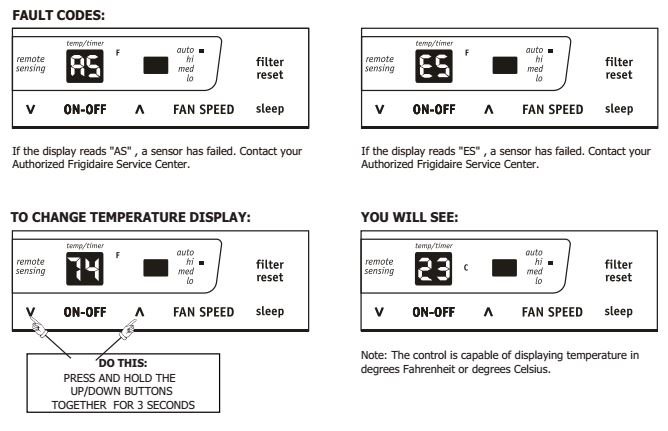
In simple terms, the “SE” error code on your Frigidaire air conditioner is its way of telling you something isn’t quite right. Think of it as your air conditioner waving a little red flag, signaling that it needs some attention. This code can appear for a variety of reasons, ranging from simple issues you can fix yourself to more complex problems that might require professional assistance. Let’s dive into what might be causing this pesky SE error and how you can address it.
Understanding the SE Error Code
The “SE” error code specifically stands for “Sensor Error.” Now, before you panic, remember that this doesn’t necessarily mean there’s a catastrophic failure. It’s more like your air conditioner nudging you to pay attention to its sensors, which are like its eyes and ears, helping it measure temperature and performance.
Imagine if you were wearing sunglasses with a smudge on them. Everything would seem a bit off, right? That’s similar to how an air conditioner’s sensor error works. The sensors can’t accurately read the temperature, which can lead to improper cooling or the unit not functioning as efficiently as it should. Sometimes, these sensors can get dirty, disconnected, or even damaged, leading to that SE error showing up on the display.
Here’s the deal: Identifying and fixing a sensor error might involve a little detective work on your part. But don’t worry, you don’t need to be an HVAC expert to understand the basics. We’ll walk through some common causes and solutions that could help you solve your air conditioner’s riddle.
Common Causes of the SE Error
First off, let’s consider dirty sensors. Just like how dust on your glasses can blur your vision, dust on the sensors can interfere with their readings. Over time, dirt and debris can accumulate, especially if the air conditioner is in an area with lots of airflow. Regular cleaning of the sensors can often resolve the issue, so it’s worth checking if this might be the culprit.
Another cause might be loose connections. Think of it like a light bulb that’s not screwed in all the way—it flickers or doesn’t turn on at all. Similarly, if the wires connecting your sensors are loose, they can’t do their job properly. Carefully checking the connections to ensure they’re secure can sometimes clear up the error code.
Finally, we have the possibility of faulty sensors. Like any small electronic part, sensors can wear out or fail over time. This is more common in older units, where the wear and tear of years of operation take their toll. If this is the case, replacing the sensors might be necessary. While this might sound daunting, replacing a sensor is often less complex than it seems and can be as straightforward as swapping out a battery.
Steps to Troubleshoot and Fix the Error
Before jumping into repairs, start with basic troubleshooting. Turn off your air conditioner and unplug it—this resets the system and can sometimes clear minor glitches. After a few minutes, plug it back in and see if the error code has disappeared. It’s like rebooting your computer to resolve a software glitch.
Next, if the error persists, attempt cleaning the sensors. Locate the sensors in your unit (the manual can help with this) and gently clean them with a soft cloth. Avoid using harsh chemicals that could damage sensitive components. Once cleaned, power the unit back on and check if the issue is resolved.
If cleaning doesn’t work, inspect the connections. With the unit unplugged, carefully check the wires that connect the sensors to the main board. Look for any signs of wear or disconnection. Re-secure any loose wires and test the unit again.
When to Call a Professional
Sometimes, the issue might be beyond a quick fix. If you’ve tried cleaning and checking connections but the error remains, it might be time to call in a professional. An HVAC technician can perform detailed diagnostics, which might reveal deeper issues such as a malfunctioning control board or more severe sensor damage.
Recognizing when to seek help can save you time and prevent further damage to your air conditioner. If you’re not comfortable handling electrical components, or if your unit is still under warranty, professional assistance is the best route. They can also offer preventative maintenance tips to help you avoid future issues.
Preventing the SE Error in the Future
To minimize the chances of encountering the SE error again, regular maintenance is key. Just like a car needs regular oil changes and check-ups, so does your air conditioner. Ensure the filters are clean, the sensors are dust-free, and the unit is serviced periodically. This not only helps prevent errors but also extends the lifespan of your appliance.
Keep an eye on environmental factors as well. If your air conditioner is in a dusty or high-traffic area, consider installing additional filters or cleaning the area more frequently. Sometimes, simply repositioning the unit to reduce dust exposure can make a significant difference.
In conclusion, while the SE error code might be a nuisance, it’s also a helpful signal that allows you to maintain and extend the life of your air conditioner. By understanding its causes and knowing how to address them, you can ensure your unit stays in top condition and continues to provide that much-needed comfort during hot weather. Happy cooling!